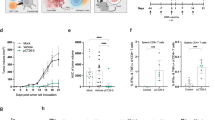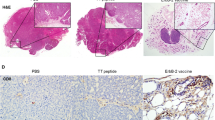Abstract
The MYCN oncogene is a strong genetic marker associated with poor prognosis in neuroblastoma (NB). Therefore, MYCN gene amplification and subsequent overexpression provide a possible target for new treatment approaches in NB. We first identified an inverse correlation of MYCN expression with CD45 mRNA in 101 NB tumor samples. KEGG mapping further revealed that MYCN expression was associated with immune-suppressive pathways characterized by a down-regulation of T cell activation and up-regulation of T cell inhibitory gene transcripts. We then aimed to investigate whether DNA vaccination against MYCN is effective to induce an antigen-specific and T cell-mediated immune response. For this purpose, we generated a MYCN-expressing syngeneic mouse model by MYCN gene transfer to NXS2 cells. MYCN-DNA vaccines were engineered based on the pCMV-F3Ub plasmid backbone to drive ubiquitinated full-length MYCN-cDNA and minigene expression. Vaccines were delivered orally with attenuated S. typhimurium strain SL7207 as a carrier. Immunization with both MYCN-DNA vaccines significantly reduced primary tumor growth of MYCN-expressing NB cells in contrast to negative controls. The immune response was mediated by tumor-infiltrating T cells in vivo, which revealed MYCN-specific and MHC class I-restricted lysis of inducible MYCN-expressing NB target cells in vitro. Finally, these antigen-specific T cells also killed MYCN-negative mammary carcinoma cells pulsed with MYCN peptides in contrast to controls. In summary, we demonstrate proof of concept that MYCN can be targeted by DNA vaccination, which may provide an approach to overcoming MYCN immune-suppressive activities in patients with MYCN-amplified disease.






Similar content being viewed by others
Abbreviations
- BET:
-
Extraterminal bromodomain Barone
- CAR:
-
Chimeric antigen receptors
- CD:
-
Cluster of differentiation
- cDNA:
-
Copy DNA
- CHO:
-
Chinese hamster ovary
- CTLs:
-
Cytotoxic T cells
- DOX:
-
Doxycycline
- ELISA:
-
Enzyme-linked immunosorbent assay
- FACS:
-
Fluorescence-activated cell sorting
- FCS:
-
Fetal calf serum
- gDNA:
-
Genomic DNA
- H:
-
Hour
- IFN:
-
Interferon
- KEGG:
-
Kyoto encyclopedia of genes and genomes
- LPS:
-
Lipopolysaccharide
- MHC:
-
Major histocompatibility complex
- MYCN:
-
Neuroblastoma-derived myelocytomatosis viral-related oncogene
- MNA:
-
MYCN amplification
- NB:
-
Neuroblastoma
- PCR:
-
Polymerase chain reaction
- RT:
-
Room temperature
- SD:
-
Standard deviation
- TAA:
-
Tumor-associated antigen
- TBS:
-
Tris-buffered saline
- TH:
-
Tyrosine hydroxylase
- TMA:
-
Tissue microarray
- wt:
-
Wild type
References
Maris JM (2010) Recent advances in neuroblastoma. N Engl J Med 362:2202–2211
Yamada S (1990) Expression of c-myc and N-myc in mouse embryos during craniofacial development. Kokubyo Gakkai Zasshi 57:83–105
Zimmerman K, Alt FW (1990) Expression and function of myc family genes. Crit Rev Oncog 2:75–95
Barone G, Anderson J, Pearson AD, Petrie K, Chesler L (2013) New strategies in neuroblastoma: therapeutic targeting of MYCN and ALK. Clin Cancer Res 19:5814–5821
Sarkar AK, Nuchtern JG (2000) Lysis of MYCN-amplified neuroblastoma cells by MYCN peptide-specific cytotoxic T lymphocytes. Cancer Res 60:1908–1913
Donnelly JJ, Ulmer JB, Shiver JW, Liu MA (1997) DNA vaccines. Annu Rev Immunol 15:617–648
Matzinger P (2002) An innate sense of danger. Ann N Y Acad Sci 961:341–342
Krieg AM (2000) The role of CpG motifs in innate immunity. Curr Opin Immunol 12:35–43
Sizemore DR, Branstrom AA, Sadoff JC (1995) Attenuated Shigella as a DNA delivery vehicle for DNA-mediated immunization. Science 270:299–302
Fest S, Huebener N, Weixler S, Bleeke M, Zeng Y, Strandsby A, Volkmer-Engert R, Landgraf C, Gaedicke G, Riemer AB, Michalsky E, Jaeger IS, Preissner R, Forster-Wald E, Jensen-Jarolim E, Lode HN (2006) Characterization of GD2 peptide mimotope DNA vaccines effective against spontaneous neuroblastoma metastases. Cancer Res 66:10567–10575
Fest S, Huebener N, Bleeke M, Durmus T, Stermann A, Woehler A, Baykan B, Zenclussen AC, Michalsky E, Jaeger IS, Preissner R, Hohn O, Weixler S, Gaedicke G, Lode HN (2009) Survivin minigene DNA vaccination is effective against neuroblastoma. Int J Cancer 125:104–114
Huebener N, Fest S, Strandsby A, Michalsky E, Preissner R, Zeng Y, Gaedicke G, Lode HN (2008) A rationally designed tyrosine hydroxylase DNA vaccine induces specific antineuroblastoma immunity. Mol Cancer Ther 7:2241–2251
Rammensee H, Bachmann J, Emmerich NP, Bachor OA, Stevanovic S (1999) SYFPEITHI: database for MHC ligands and peptide motifs. Immunogenetics 50:213–219
Parker KC, Bednarek MA, Coligan JE (1994) Scheme for ranking potential HLA-A2 binding peptides based on independent binding of individual peptide side-chains. J Immunol 152:163–175
Whitton JL, Oldstone MB (1989) Class I MHC can present an endogenous peptide to cytotoxic T lymphocytes. J Exp Med 170:1033–1038
Whitton JL (1994) Induction of protective immunity using minigenes. Ann N Y Acad Sci 730:107–117
Huebener N, Lange B, Lemmel C, Rammensee HG, Strandsby A, Wenkel J, Jikai J, Zeng Y, Gaedicke G, Lode HN (2003) Vaccination with minigenes encoding for novel ‘self’ antigens are effective in DNA-vaccination against neuroblastoma. Cancer Lett 197:211–217
Lewen S, Zhou H, Hu H, Cheng T, Markowitz D, Reisfeld R, Xiang R, Luo Y (2008) A Legumain-based minigene vaccine targets the tumor stroma and suppresses breast cancer growth and angiogenesis. Cancer Immunol Immunother 57:507–515
Lode HN, Huebener N, Zeng Y, Fest S, Weixler S, Gaedicke G (2004) DNA minigene vaccination for adjuvant neuroblastoma therapy. Ann N Y Acad Sci 1028:113–121
Berger E, Soldati R, Huebener N, Hohn O, Stermann A, Durmus T, Lobitz S, Zenclussen AC, Christiansen H, Lode HN, Fest S (2013) Salmonella SL7207 application is the most effective DNA vaccine delivery method for successful tumor eradication in a murine model for neuroblastoma. Cancer Lett 331(2):167–173
Levine MM, Galen J, Barry E, Noriega F, Chatfield S, Sztein M, Dougan G, Tacket C (1996) Attenuated Salmonella as live oral vaccines against typhoid fever and as live vectors. J Biotechnol 44:193–196
Schramm A, Schowe B, Fielitz K, Heilmann M, Martin M, Marschall T, Koster J, Vandesompele J, Vermeulen J, De Preter K, Koster J, Versteeg R, Noguera R, Speleman F, Rahmann S, Eggert A, Morik K, Schulte JH (2012) Exon-level expression analyses identify MYCN and NTRK1 as major determinants of alternative exon usage and robustly predict primary neuroblastoma outcome. Br J Cancer 107:1409–1417
Pajtler KW, Rebmann V, Lindemann M, Schulte JH, Schulte S, Stauder M, Leuschner I, Schmid KW, Kohl U, Schramm A, Eggert A (2013) Expression of NTRK1/TrkA affects immunogenicity of neuroblastoma cells. Int J Cancer 133:908–919
Zeng Y, Huebener N, Fest S, Weixler S, Schroeder U, Gaedicke G, Xiang R, Schramm A, Eggert A, Reisfeld RA, Lode HN (2007) Fractalkine (CX3CL1)- and interleukin-2-enriched neuroblastoma microenvironment induces eradication of metastases mediated by T cells and natural killer cells. Cancer Res 67:2331–2338
Velders MP, Weijzen S, Eiben GL, Elmishad AG, Kloetzel PM, Higgins T, Ciccarelli RB, Evans M, Man S, Smith L, Kast WM (2001) Defined flanking spacers and enhanced proteolysis is essential for eradication of established tumors by an epitope string DNA vaccine. J Immunol 166:5366–5373
Michalek MT, Grant EP, Gramm C, Goldberg AL, Rock KL (1993) A role for the ubiquitin-dependent proteolytic pathway in MHC class I-restricted antigen presentation. Nature 363:552–554
Sijts A, Zaiss D, Kloetzel PM (2001) The role of the ubiquitin-proteasome pathway in MHC class I antigen processing: implications for vaccine design. Curr Mol Med 1:665–676
Lode HN, Reisfeld RA (2000) Targeted cytokines for cancer immunotherapy. Immunol Res 21:279–288
Huebener N, Fest S, Hilt K, Schramm A, Eggert A, Durmus T, Woehler A, Stermann A, Bleeke M, Baykan B, Weixler S, Gaedicke G, Lode HN (2009) Xenogeneic immunization with human tyrosine hydroxylase DNA vaccines suppresses growth of established neuroblastoma. Mol Cancer Ther 8:2392–2401
Rennel E, Gerwins P (2002) How to make tetracycline-regulated transgene expression go on and off. Anal Biochem 309:79–84
Forloni M, Albini S, Limongi MZ, Cifaldi L, Boldrini R, Nicotra MR, Giannini G, Natali PG, Giacomini P, Fruci D (2010) NF-kappaB, and not MYCN, regulates MHC class I and endoplasmic reticulum aminopeptidases in human neuroblastoma cells. Cancer Res 70:916–924
Facchetti P, Prigione I, Ghiotto F, Tasso P, Garaventa A, Pistoia V (1996) Functional and molecular characterization of tumour-infiltrating lymphocytes and clones thereof from a major-histocompatibility-complex-negative human tumour: neuroblastoma. Cancer Immunol Immunother 42:170–178
Martin RF, Beckwith JB (1968) Lymphoid infiltrates in neuroblastomas: their occurrence and prognostic significance. J Pediatr Surg 3:161–164
Pellat-Deceunynck C, Bataille R (2004) Normal and malignant human plasma cells: proliferation, differentiation, and expansions in relation to CD45 expression. Blood Cells Mol Dis 32:293–301
Rodriguez F, An LL, Harkins S, Zhang J, Yokoyama M, Widera G, Fuller JT, Kincaid C, Campbell IL, Whitton JL (1998) DNA immunization with minigenes: low frequency of memory cytotoxic T lymphocytes and inefficient antiviral protection are rectified by ubiquitination. J Virol 72:5174–5181
Gerloni M, Zanetti M (2005) CD4 T cells in tumor immunity. Springer Semin Immunopathol 27:37–48
Groux H (2003) Type 1 T-regulatory cells: their role in the control of immune responses. Transplantation 75:8S–12S
Tudor D, Dubuquoy C, Gaboriau V, Lefevre F, Charley B, Riffault S (2005) TLR9 pathway is involved in adjuvant effects of plasmid DNA-based vaccines. Vaccine 23:1258–1264
Fruci D, Niedermann G, Butler RH, van Endert PM (2001) Efficient MHC class I-independent amino-terminal trimming of epitope precursor peptides in the endoplasmic reticulum. Immunity 15:467–476
Xiang R, Luo Y, Niethammer AG, Reisfeld RA (2008) Oral DNA vaccines target the tumor vasculature and microenvironment and suppress tumor growth and metastasis. Immunol Rev 222:117–128
Spierings DC, Agsteribbe E, Wilschut J, Huckriede A (2000) Characterization of antigen-presenting properties of tumour cells using virus-specific cytotoxic T lymphocytes. Br J Cancer 82:1474–1479
Sykulev Y, Joo M, Vturina I, Tsomides TJ, Eisen HN (1996) Evidence that a single peptide–MHC complex on a target cell can elicit a cytolytic T cell response. Immunity 4:565–571
Christinck ER, Luscher MA, Barber BH, Williams David B (1991) Peptide binding to class I MHC on living cells and quantitation of complexes required for CTL lysis. Nature 352:67–70
Strehl B, Seifert U, Kruger E, Heink S, Kuckelkorn U, Kloetzel PM (2005) Interferon-gamma, the functional plasticity of the ubiquitin-proteasome system, and MHC class I antigen processing. Immunol Rev 207:19–30
Whitby FG, Masters EI, Kramer L, Knowlton JR, Yao Y, Wang CC, Hill CP (2000) Structural basis for the activation of 20S proteasomes by 11S regulators. Nature 408:115–120
Matthay KK, George RE, Yu AL (2012) Promising therapeutic targets in neuroblastoma. Clin Cancer Res 18:2740–2753
Heczey A, Louis CU (2013) Advances in chimeric antigen receptor immunotherapy for neuroblastoma. Discov Med 16:287–294
Acknowledgments
This work was supported by NGFNplus (Bundesministerium für Bildung und Forschung, ENGINE).
Conflict of interest
We have no conflict of interest to disclose.
Ethical approval
All applicable international, national and/or institutional guidelines for the care and use of animals were followed. All procedures performed in studies involving human participants were in accordance with the ethical standards of the institutional and/or national research committee and with the 1964 Helsinki Declaration and its later amendments or comparable ethical standards.
Author information
Authors and Affiliations
Corresponding author
Rights and permissions
About this article
Cite this article
Stermann, A., Huebener, N., Seidel, D. et al. Targeting of MYCN by means of DNA vaccination is effective against neuroblastoma in mice. Cancer Immunol Immunother 64, 1215–1227 (2015). https://doi.org/10.1007/s00262-015-1733-1
Received:
Accepted:
Published:
Issue Date:
DOI: https://doi.org/10.1007/s00262-015-1733-1




